BSB80615 Innovation Plan: Leading Innovative Thinking and Practice
VerifiedAdded on 2022/10/16
|33
|6727
|11
Report
AI Summary
This comprehensive report presents an in-depth analysis of an innovation plan, addressing key aspects of business development and leadership. It begins by exploring the evolution of perspectives on innovation and its significance for stakeholders, emphasizing the value of innovation in product development and customer satisfaction. The report then delves into the role of innovation theory and thinking in organizations, including its impact on revenue generation, supply chain management, and environmental sustainability. Furthermore, it examines various leadership styles and their influence on innovation, comparing autocratic, democratic, laissez-faire, strategic, and transformative approaches. The report also assesses the impact of macro-economic factors on innovation and identifies critical success factors such as political, economic, technological, social, legal, and environmental factors. A significant portion of the report focuses on risk management, outlining the steps involved in creating a risk management policy, identifying and reporting risks, and forming risk management strategies. Finally, the report includes a case study on L'Oreal, analyzing its innovation practices and providing recommendations for further innovation implementation, including stakeholder engagement, team collaboration, resource allocation, and the establishment of supporting systems and processes. This report is a valuable resource for students studying business innovation, providing practical insights and strategies for leading innovative thinking and practice.

Running head: INNOVATION PLAN
INNOVATION PLAN
Name of the Student:
Name of the University:
Author Note:
INNOVATION PLAN
Name of the Student:
Name of the University:
Author Note:
Paraphrase This Document
Need a fresh take? Get an instant paraphrase of this document with our AI Paraphraser
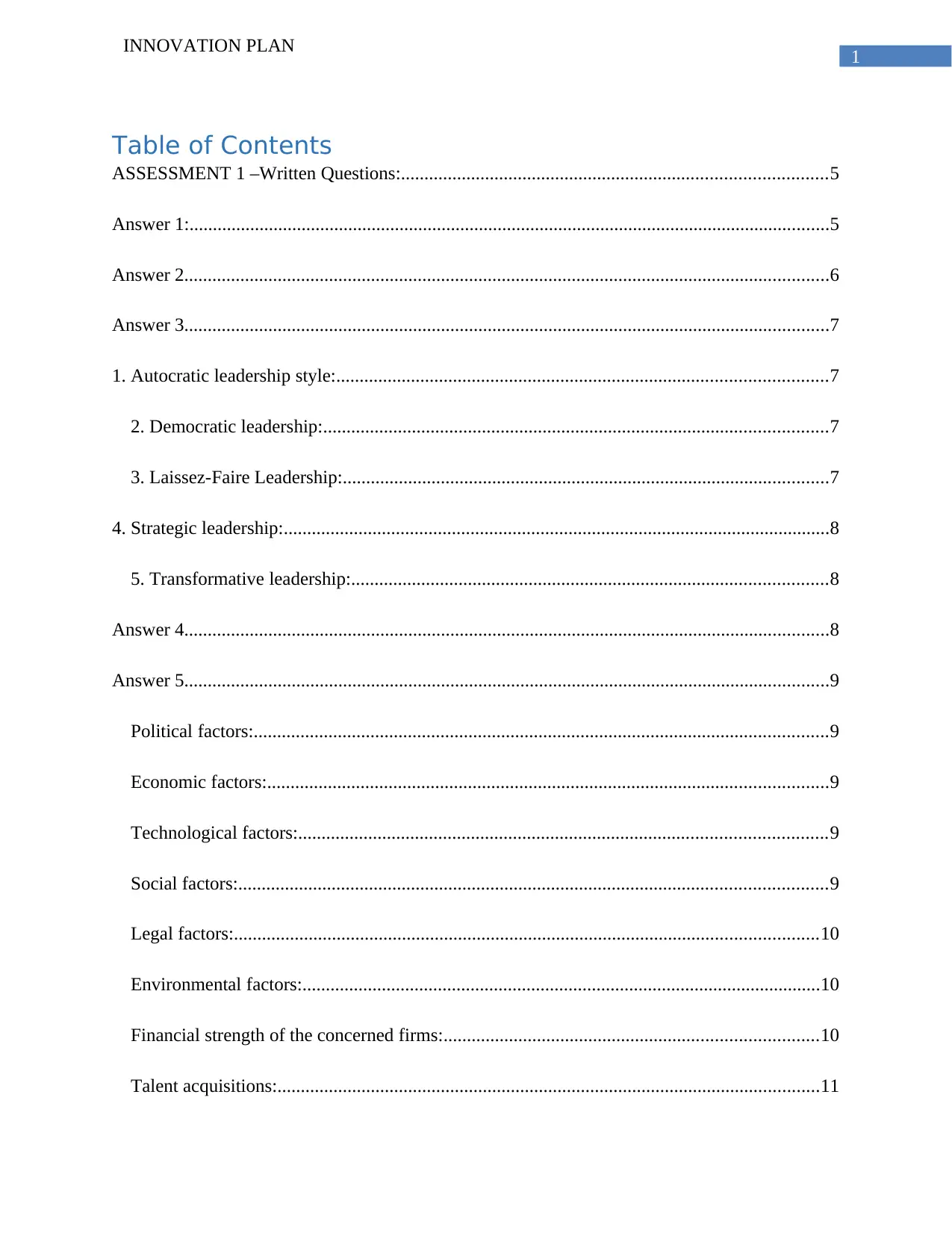
1
INNOVATION PLAN
Table of Contents
ASSESSMENT 1 –Written Questions:...........................................................................................5
Answer 1:.........................................................................................................................................5
Answer 2..........................................................................................................................................6
Answer 3..........................................................................................................................................7
1. Autocratic leadership style:.........................................................................................................7
2. Democratic leadership:............................................................................................................7
3. Laissez-Faire Leadership:........................................................................................................7
4. Strategic leadership:.....................................................................................................................8
5. Transformative leadership:......................................................................................................8
Answer 4..........................................................................................................................................8
Answer 5..........................................................................................................................................9
Political factors:...........................................................................................................................9
Economic factors:........................................................................................................................9
Technological factors:.................................................................................................................9
Social factors:..............................................................................................................................9
Legal factors:.............................................................................................................................10
Environmental factors:...............................................................................................................10
Financial strength of the concerned firms:................................................................................10
Talent acquisitions:....................................................................................................................11
INNOVATION PLAN
Table of Contents
ASSESSMENT 1 –Written Questions:...........................................................................................5
Answer 1:.........................................................................................................................................5
Answer 2..........................................................................................................................................6
Answer 3..........................................................................................................................................7
1. Autocratic leadership style:.........................................................................................................7
2. Democratic leadership:............................................................................................................7
3. Laissez-Faire Leadership:........................................................................................................7
4. Strategic leadership:.....................................................................................................................8
5. Transformative leadership:......................................................................................................8
Answer 4..........................................................................................................................................8
Answer 5..........................................................................................................................................9
Political factors:...........................................................................................................................9
Economic factors:........................................................................................................................9
Technological factors:.................................................................................................................9
Social factors:..............................................................................................................................9
Legal factors:.............................................................................................................................10
Environmental factors:...............................................................................................................10
Financial strength of the concerned firms:................................................................................10
Talent acquisitions:....................................................................................................................11
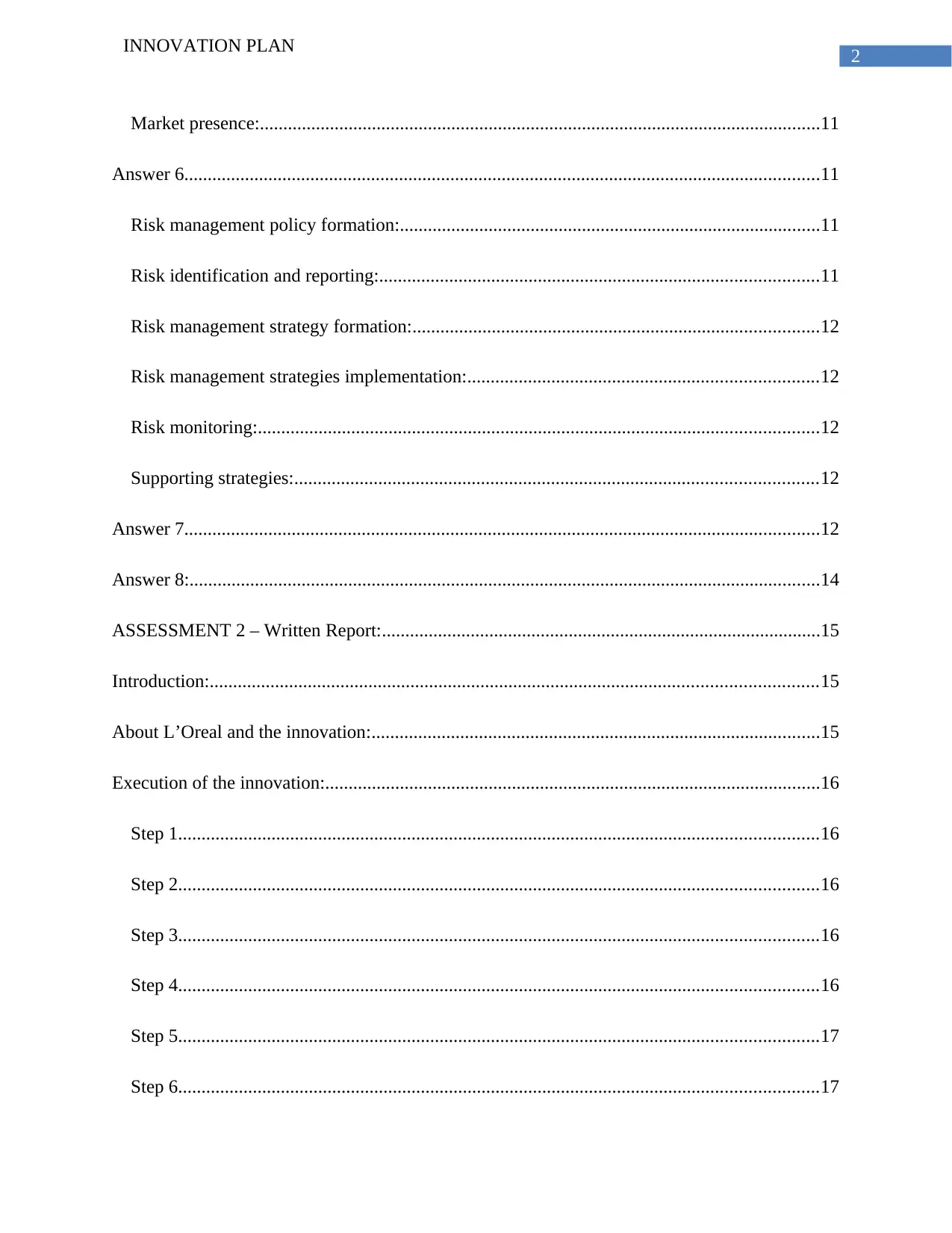
2
INNOVATION PLAN
Market presence:........................................................................................................................11
Answer 6........................................................................................................................................11
Risk management policy formation:..........................................................................................11
Risk identification and reporting:..............................................................................................11
Risk management strategy formation:.......................................................................................12
Risk management strategies implementation:...........................................................................12
Risk monitoring:........................................................................................................................12
Supporting strategies:................................................................................................................12
Answer 7........................................................................................................................................12
Answer 8:.......................................................................................................................................14
ASSESSMENT 2 – Written Report:..............................................................................................15
Introduction:..................................................................................................................................15
About L’Oreal and the innovation:................................................................................................15
Execution of the innovation:..........................................................................................................16
Step 1.........................................................................................................................................16
Step 2.........................................................................................................................................16
Step 3.........................................................................................................................................16
Step 4.........................................................................................................................................16
Step 5.........................................................................................................................................17
Step 6.........................................................................................................................................17
INNOVATION PLAN
Market presence:........................................................................................................................11
Answer 6........................................................................................................................................11
Risk management policy formation:..........................................................................................11
Risk identification and reporting:..............................................................................................11
Risk management strategy formation:.......................................................................................12
Risk management strategies implementation:...........................................................................12
Risk monitoring:........................................................................................................................12
Supporting strategies:................................................................................................................12
Answer 7........................................................................................................................................12
Answer 8:.......................................................................................................................................14
ASSESSMENT 2 – Written Report:..............................................................................................15
Introduction:..................................................................................................................................15
About L’Oreal and the innovation:................................................................................................15
Execution of the innovation:..........................................................................................................16
Step 1.........................................................................................................................................16
Step 2.........................................................................................................................................16
Step 3.........................................................................................................................................16
Step 4.........................................................................................................................................16
Step 5.........................................................................................................................................17
Step 6.........................................................................................................................................17
⊘ This is a preview!⊘
Do you want full access?
Subscribe today to unlock all pages.

Trusted by 1+ million students worldwide
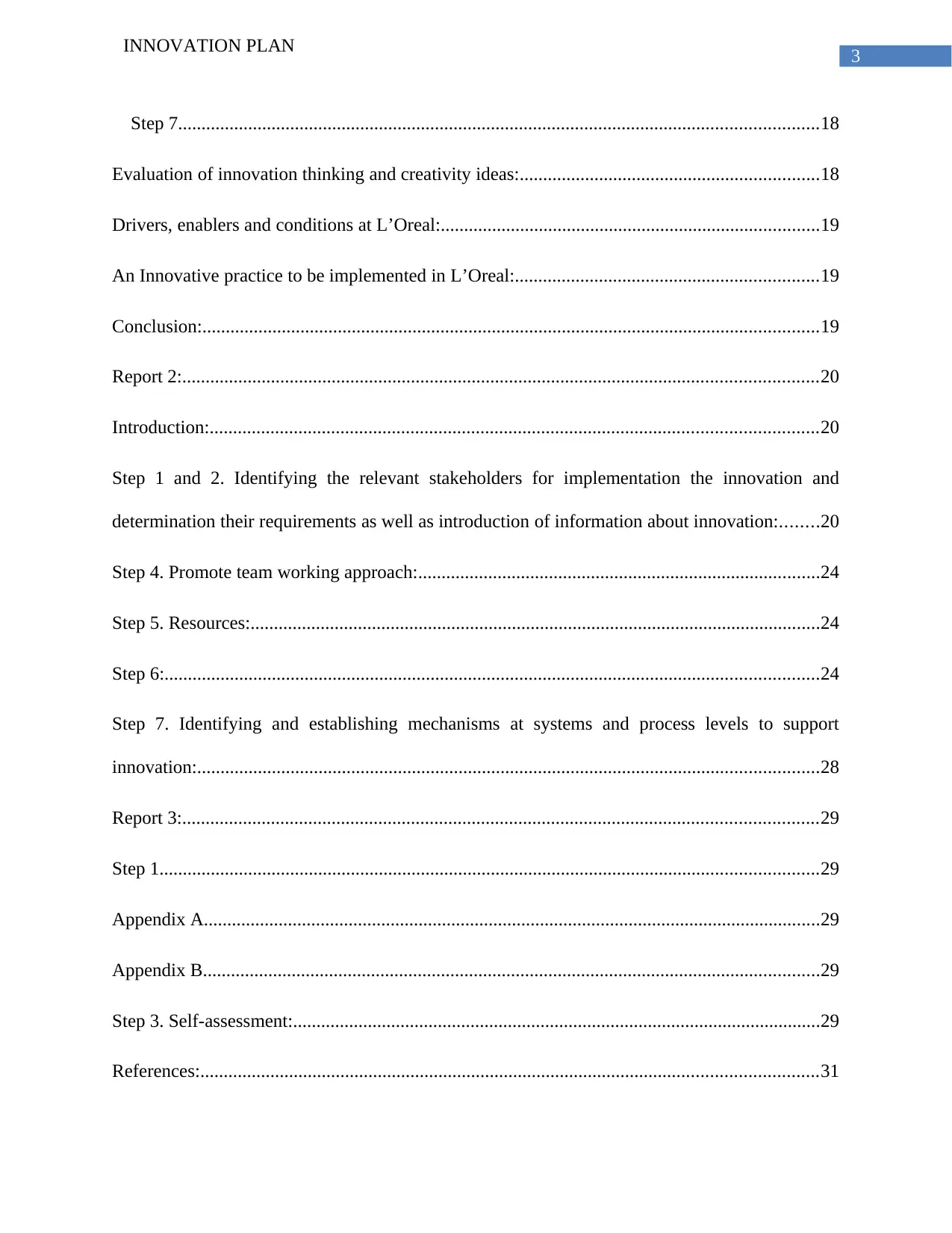
3
INNOVATION PLAN
Step 7.........................................................................................................................................18
Evaluation of innovation thinking and creativity ideas:................................................................18
Drivers, enablers and conditions at L’Oreal:.................................................................................19
An Innovative practice to be implemented in L’Oreal:.................................................................19
Conclusion:....................................................................................................................................19
Report 2:........................................................................................................................................20
Introduction:..................................................................................................................................20
Step 1 and 2. Identifying the relevant stakeholders for implementation the innovation and
determination their requirements as well as introduction of information about innovation:........20
Step 4. Promote team working approach:......................................................................................24
Step 5. Resources:..........................................................................................................................24
Step 6:............................................................................................................................................24
Step 7. Identifying and establishing mechanisms at systems and process levels to support
innovation:.....................................................................................................................................28
Report 3:........................................................................................................................................29
Step 1.............................................................................................................................................29
Appendix A....................................................................................................................................29
Appendix B....................................................................................................................................29
Step 3. Self-assessment:.................................................................................................................29
References:....................................................................................................................................31
INNOVATION PLAN
Step 7.........................................................................................................................................18
Evaluation of innovation thinking and creativity ideas:................................................................18
Drivers, enablers and conditions at L’Oreal:.................................................................................19
An Innovative practice to be implemented in L’Oreal:.................................................................19
Conclusion:....................................................................................................................................19
Report 2:........................................................................................................................................20
Introduction:..................................................................................................................................20
Step 1 and 2. Identifying the relevant stakeholders for implementation the innovation and
determination their requirements as well as introduction of information about innovation:........20
Step 4. Promote team working approach:......................................................................................24
Step 5. Resources:..........................................................................................................................24
Step 6:............................................................................................................................................24
Step 7. Identifying and establishing mechanisms at systems and process levels to support
innovation:.....................................................................................................................................28
Report 3:........................................................................................................................................29
Step 1.............................................................................................................................................29
Appendix A....................................................................................................................................29
Appendix B....................................................................................................................................29
Step 3. Self-assessment:.................................................................................................................29
References:....................................................................................................................................31
Paraphrase This Document
Need a fresh take? Get an instant paraphrase of this document with our AI Paraphraser

4
INNOVATION PLAN
INNOVATION PLAN
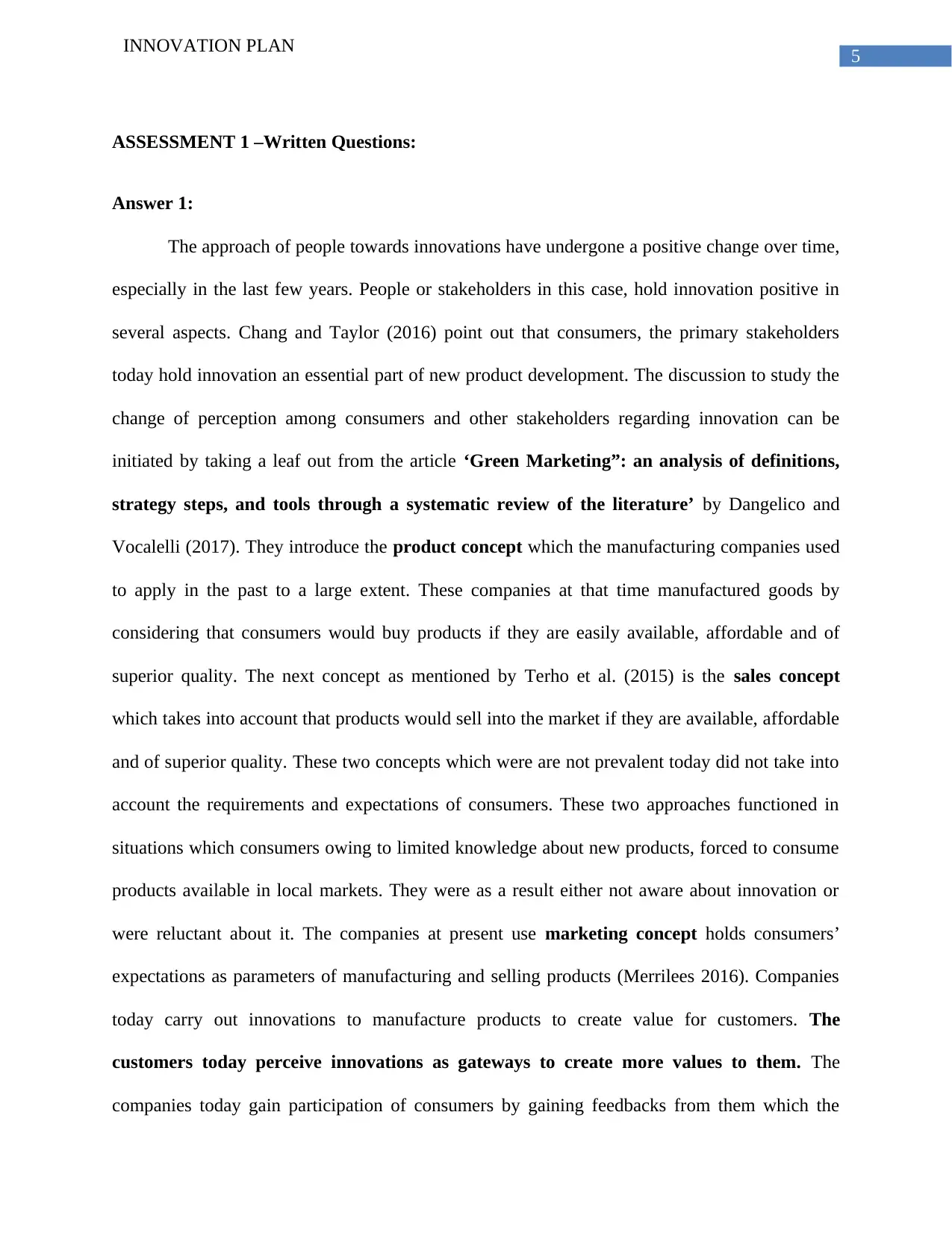
5
INNOVATION PLAN
ASSESSMENT 1 –Written Questions:
Answer 1:
The approach of people towards innovations have undergone a positive change over time,
especially in the last few years. People or stakeholders in this case, hold innovation positive in
several aspects. Chang and Taylor (2016) point out that consumers, the primary stakeholders
today hold innovation an essential part of new product development. The discussion to study the
change of perception among consumers and other stakeholders regarding innovation can be
initiated by taking a leaf out from the article ‘Green Marketing”: an analysis of definitions,
strategy steps, and tools through a systematic review of the literature’ by Dangelico and
Vocalelli (2017). They introduce the product concept which the manufacturing companies used
to apply in the past to a large extent. These companies at that time manufactured goods by
considering that consumers would buy products if they are easily available, affordable and of
superior quality. The next concept as mentioned by Terho et al. (2015) is the sales concept
which takes into account that products would sell into the market if they are available, affordable
and of superior quality. These two concepts which were are not prevalent today did not take into
account the requirements and expectations of consumers. These two approaches functioned in
situations which consumers owing to limited knowledge about new products, forced to consume
products available in local markets. They were as a result either not aware about innovation or
were reluctant about it. The companies at present use marketing concept holds consumers’
expectations as parameters of manufacturing and selling products (Merrilees 2016). Companies
today carry out innovations to manufacture products to create value for customers. The
customers today perceive innovations as gateways to create more values to them. The
companies today gain participation of consumers by gaining feedbacks from them which the
INNOVATION PLAN
ASSESSMENT 1 –Written Questions:
Answer 1:
The approach of people towards innovations have undergone a positive change over time,
especially in the last few years. People or stakeholders in this case, hold innovation positive in
several aspects. Chang and Taylor (2016) point out that consumers, the primary stakeholders
today hold innovation an essential part of new product development. The discussion to study the
change of perception among consumers and other stakeholders regarding innovation can be
initiated by taking a leaf out from the article ‘Green Marketing”: an analysis of definitions,
strategy steps, and tools through a systematic review of the literature’ by Dangelico and
Vocalelli (2017). They introduce the product concept which the manufacturing companies used
to apply in the past to a large extent. These companies at that time manufactured goods by
considering that consumers would buy products if they are easily available, affordable and of
superior quality. The next concept as mentioned by Terho et al. (2015) is the sales concept
which takes into account that products would sell into the market if they are available, affordable
and of superior quality. These two concepts which were are not prevalent today did not take into
account the requirements and expectations of consumers. These two approaches functioned in
situations which consumers owing to limited knowledge about new products, forced to consume
products available in local markets. They were as a result either not aware about innovation or
were reluctant about it. The companies at present use marketing concept holds consumers’
expectations as parameters of manufacturing and selling products (Merrilees 2016). Companies
today carry out innovations to manufacture products to create value for customers. The
customers today perceive innovations as gateways to create more values to them. The
companies today gain participation of consumers by gaining feedbacks from them which the
⊘ This is a preview!⊘
Do you want full access?
Subscribe today to unlock all pages.

Trusted by 1+ million students worldwide
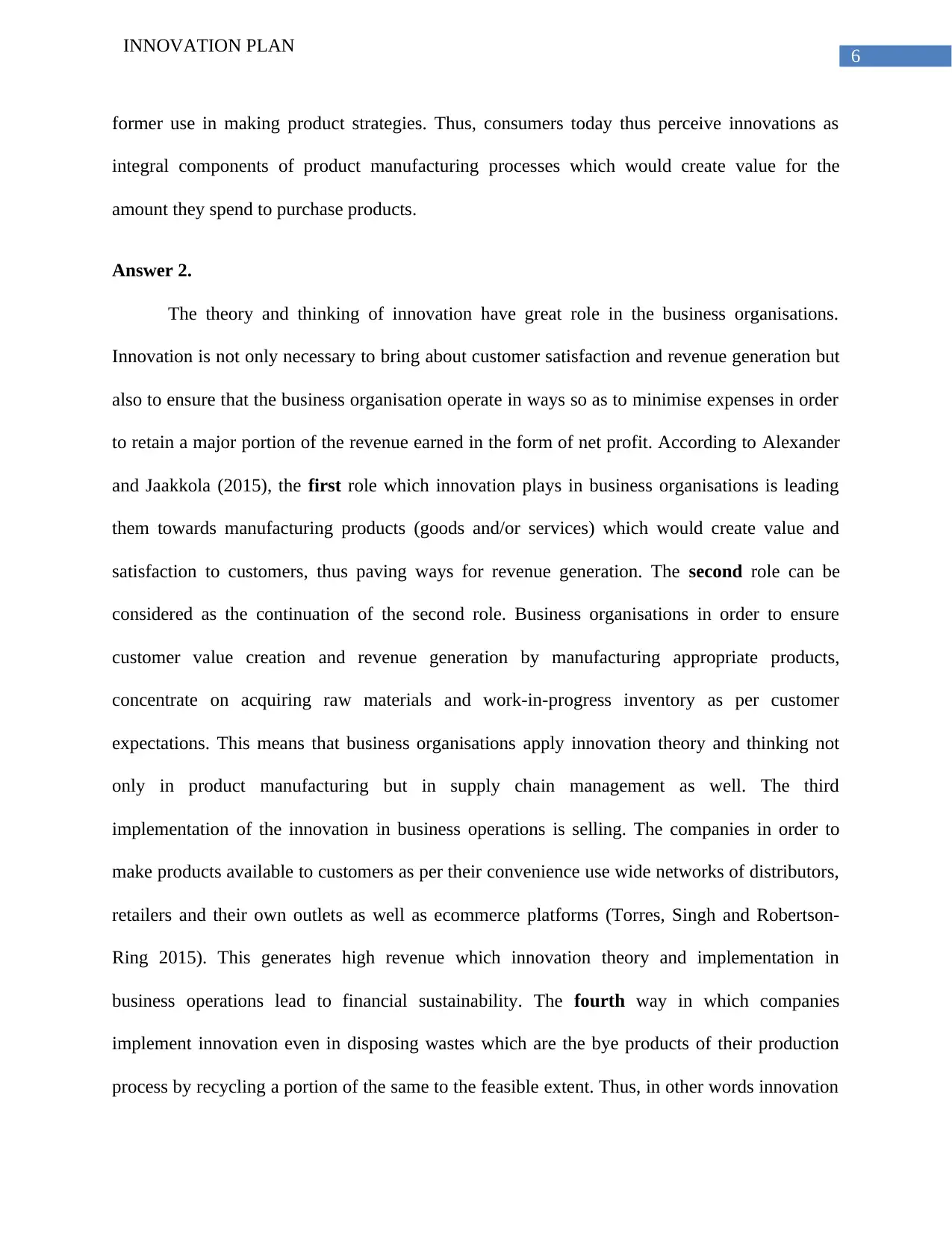
6
INNOVATION PLAN
former use in making product strategies. Thus, consumers today thus perceive innovations as
integral components of product manufacturing processes which would create value for the
amount they spend to purchase products.
Answer 2.
The theory and thinking of innovation have great role in the business organisations.
Innovation is not only necessary to bring about customer satisfaction and revenue generation but
also to ensure that the business organisation operate in ways so as to minimise expenses in order
to retain a major portion of the revenue earned in the form of net profit. According to Alexander
and Jaakkola (2015), the first role which innovation plays in business organisations is leading
them towards manufacturing products (goods and/or services) which would create value and
satisfaction to customers, thus paving ways for revenue generation. The second role can be
considered as the continuation of the second role. Business organisations in order to ensure
customer value creation and revenue generation by manufacturing appropriate products,
concentrate on acquiring raw materials and work-in-progress inventory as per customer
expectations. This means that business organisations apply innovation theory and thinking not
only in product manufacturing but in supply chain management as well. The third
implementation of the innovation in business operations is selling. The companies in order to
make products available to customers as per their convenience use wide networks of distributors,
retailers and their own outlets as well as ecommerce platforms (Torres, Singh and Robertson-
Ring 2015). This generates high revenue which innovation theory and implementation in
business operations lead to financial sustainability. The fourth way in which companies
implement innovation even in disposing wastes which are the bye products of their production
process by recycling a portion of the same to the feasible extent. Thus, in other words innovation
INNOVATION PLAN
former use in making product strategies. Thus, consumers today thus perceive innovations as
integral components of product manufacturing processes which would create value for the
amount they spend to purchase products.
Answer 2.
The theory and thinking of innovation have great role in the business organisations.
Innovation is not only necessary to bring about customer satisfaction and revenue generation but
also to ensure that the business organisation operate in ways so as to minimise expenses in order
to retain a major portion of the revenue earned in the form of net profit. According to Alexander
and Jaakkola (2015), the first role which innovation plays in business organisations is leading
them towards manufacturing products (goods and/or services) which would create value and
satisfaction to customers, thus paving ways for revenue generation. The second role can be
considered as the continuation of the second role. Business organisations in order to ensure
customer value creation and revenue generation by manufacturing appropriate products,
concentrate on acquiring raw materials and work-in-progress inventory as per customer
expectations. This means that business organisations apply innovation theory and thinking not
only in product manufacturing but in supply chain management as well. The third
implementation of the innovation in business operations is selling. The companies in order to
make products available to customers as per their convenience use wide networks of distributors,
retailers and their own outlets as well as ecommerce platforms (Torres, Singh and Robertson-
Ring 2015). This generates high revenue which innovation theory and implementation in
business operations lead to financial sustainability. The fourth way in which companies
implement innovation even in disposing wastes which are the bye products of their production
process by recycling a portion of the same to the feasible extent. Thus, in other words innovation
Paraphrase This Document
Need a fresh take? Get an instant paraphrase of this document with our AI Paraphraser

7
INNOVATION PLAN
theory and planning has paved ways for business organisations to encourage environmental
sustainability and establish themselves as socially responsible corporate citizens.
Answer 3.
The following are the five of leadership styles explained in brief:
1. Autocratic leadership style:
Autocratic leadership style is the leadership style in which leaders make decisions
without consulting their subordinates and followers. The leaders following this style of
leadership expect prompt execution of command from their subordinate and do not expect any
feedback. This style of leadership provides limited flexibility of operations and inhibits
innovation. The employees operating under autocratic leadership style experience low level of
involvement in their job and suffer from low job satisfaction.
2. Democratic leadership:
Democratic leadership consists of leaders involving the entire in forming decisions and
usually give importance to the opinions of the followers. This type of leadership enables the
junior employees to express their feedback on the decision taken by the leader which in turn
creates a positive impact on the latter (Iqbal, Anwar and Haider 2015). Khan et al. (2015)
mention that this style of leadership allows a great of leader and follower collaboration and
enables greater degree of flexibility.
3. Laissez-Faire Leadership:
This style of leadership is characterized by the lack on control of intervention and control
of leader over the employees. According to Wong and Giessner (2018) this type of leadership is
appropriate in situations when followers are fully to their respective performances. However, in
INNOVATION PLAN
theory and planning has paved ways for business organisations to encourage environmental
sustainability and establish themselves as socially responsible corporate citizens.
Answer 3.
The following are the five of leadership styles explained in brief:
1. Autocratic leadership style:
Autocratic leadership style is the leadership style in which leaders make decisions
without consulting their subordinates and followers. The leaders following this style of
leadership expect prompt execution of command from their subordinate and do not expect any
feedback. This style of leadership provides limited flexibility of operations and inhibits
innovation. The employees operating under autocratic leadership style experience low level of
involvement in their job and suffer from low job satisfaction.
2. Democratic leadership:
Democratic leadership consists of leaders involving the entire in forming decisions and
usually give importance to the opinions of the followers. This type of leadership enables the
junior employees to express their feedback on the decision taken by the leader which in turn
creates a positive impact on the latter (Iqbal, Anwar and Haider 2015). Khan et al. (2015)
mention that this style of leadership allows a great of leader and follower collaboration and
enables greater degree of flexibility.
3. Laissez-Faire Leadership:
This style of leadership is characterized by the lack on control of intervention and control
of leader over the employees. According to Wong and Giessner (2018) this type of leadership is
appropriate in situations when followers are fully to their respective performances. However, in
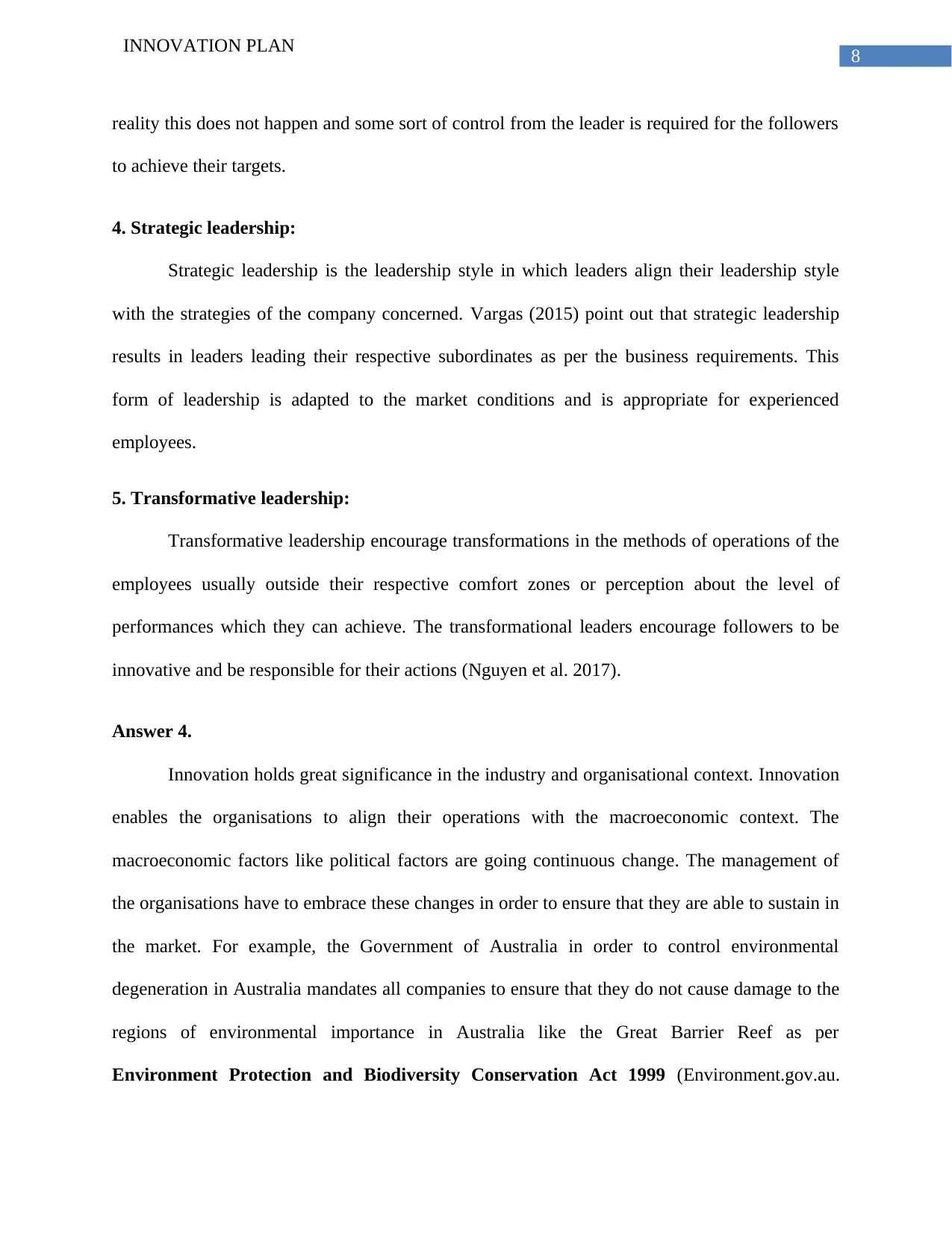
8
INNOVATION PLAN
reality this does not happen and some sort of control from the leader is required for the followers
to achieve their targets.
4. Strategic leadership:
Strategic leadership is the leadership style in which leaders align their leadership style
with the strategies of the company concerned. Vargas (2015) point out that strategic leadership
results in leaders leading their respective subordinates as per the business requirements. This
form of leadership is adapted to the market conditions and is appropriate for experienced
employees.
5. Transformative leadership:
Transformative leadership encourage transformations in the methods of operations of the
employees usually outside their respective comfort zones or perception about the level of
performances which they can achieve. The transformational leaders encourage followers to be
innovative and be responsible for their actions (Nguyen et al. 2017).
Answer 4.
Innovation holds great significance in the industry and organisational context. Innovation
enables the organisations to align their operations with the macroeconomic context. The
macroeconomic factors like political factors are going continuous change. The management of
the organisations have to embrace these changes in order to ensure that they are able to sustain in
the market. For example, the Government of Australia in order to control environmental
degeneration in Australia mandates all companies to ensure that they do not cause damage to the
regions of environmental importance in Australia like the Great Barrier Reef as per
Environment Protection and Biodiversity Conservation Act 1999 (Environment.gov.au.
INNOVATION PLAN
reality this does not happen and some sort of control from the leader is required for the followers
to achieve their targets.
4. Strategic leadership:
Strategic leadership is the leadership style in which leaders align their leadership style
with the strategies of the company concerned. Vargas (2015) point out that strategic leadership
results in leaders leading their respective subordinates as per the business requirements. This
form of leadership is adapted to the market conditions and is appropriate for experienced
employees.
5. Transformative leadership:
Transformative leadership encourage transformations in the methods of operations of the
employees usually outside their respective comfort zones or perception about the level of
performances which they can achieve. The transformational leaders encourage followers to be
innovative and be responsible for their actions (Nguyen et al. 2017).
Answer 4.
Innovation holds great significance in the industry and organisational context. Innovation
enables the organisations to align their operations with the macroeconomic context. The
macroeconomic factors like political factors are going continuous change. The management of
the organisations have to embrace these changes in order to ensure that they are able to sustain in
the market. For example, the Government of Australia in order to control environmental
degeneration in Australia mandates all companies to ensure that they do not cause damage to the
regions of environmental importance in Australia like the Great Barrier Reef as per
Environment Protection and Biodiversity Conservation Act 1999 (Environment.gov.au.
⊘ This is a preview!⊘
Do you want full access?
Subscribe today to unlock all pages.

Trusted by 1+ million students worldwide
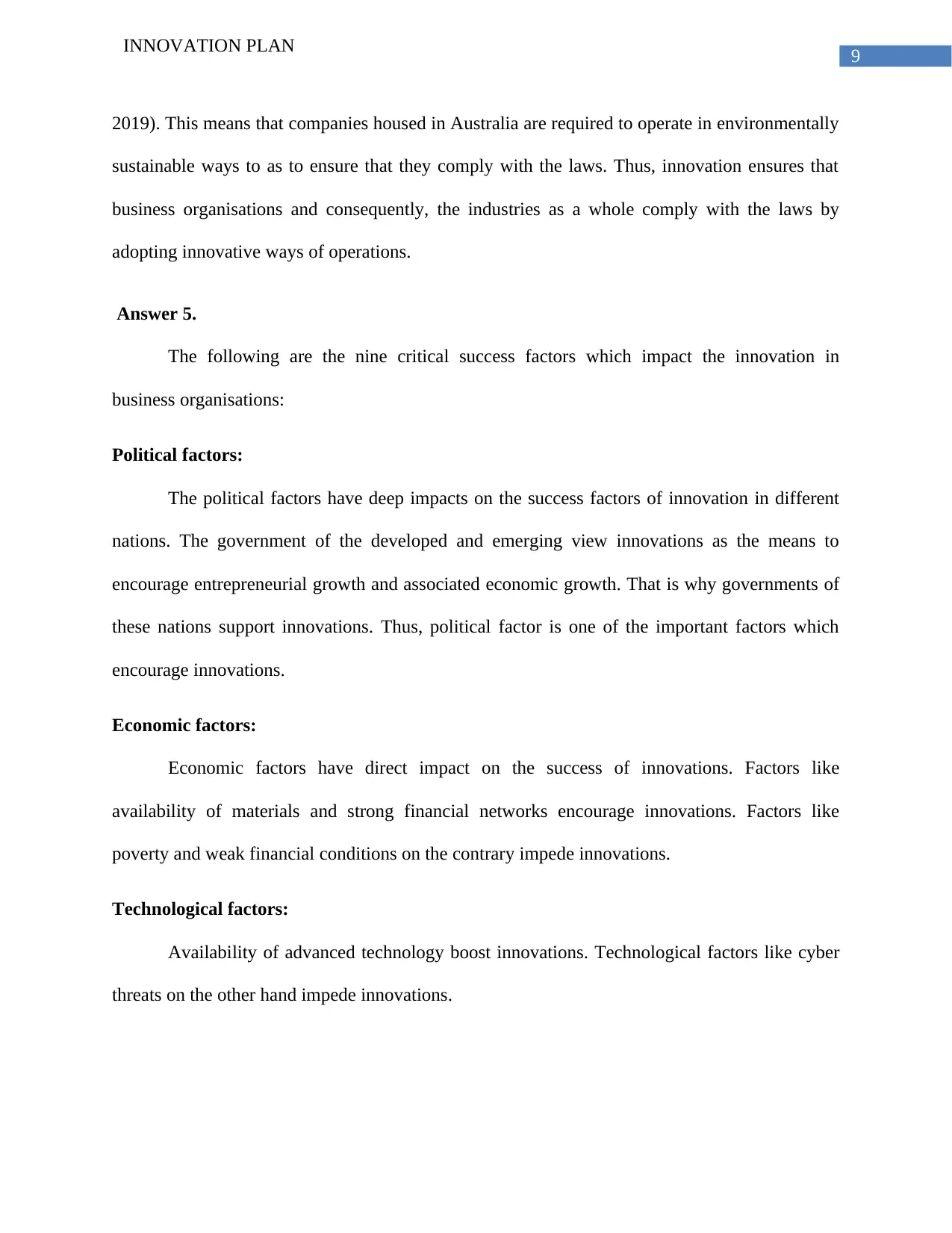
9
INNOVATION PLAN
2019). This means that companies housed in Australia are required to operate in environmentally
sustainable ways to as to ensure that they comply with the laws. Thus, innovation ensures that
business organisations and consequently, the industries as a whole comply with the laws by
adopting innovative ways of operations.
Answer 5.
The following are the nine critical success factors which impact the innovation in
business organisations:
Political factors:
The political factors have deep impacts on the success factors of innovation in different
nations. The government of the developed and emerging view innovations as the means to
encourage entrepreneurial growth and associated economic growth. That is why governments of
these nations support innovations. Thus, political factor is one of the important factors which
encourage innovations.
Economic factors:
Economic factors have direct impact on the success of innovations. Factors like
availability of materials and strong financial networks encourage innovations. Factors like
poverty and weak financial conditions on the contrary impede innovations.
Technological factors:
Availability of advanced technology boost innovations. Technological factors like cyber
threats on the other hand impede innovations.
INNOVATION PLAN
2019). This means that companies housed in Australia are required to operate in environmentally
sustainable ways to as to ensure that they comply with the laws. Thus, innovation ensures that
business organisations and consequently, the industries as a whole comply with the laws by
adopting innovative ways of operations.
Answer 5.
The following are the nine critical success factors which impact the innovation in
business organisations:
Political factors:
The political factors have deep impacts on the success factors of innovation in different
nations. The government of the developed and emerging view innovations as the means to
encourage entrepreneurial growth and associated economic growth. That is why governments of
these nations support innovations. Thus, political factor is one of the important factors which
encourage innovations.
Economic factors:
Economic factors have direct impact on the success of innovations. Factors like
availability of materials and strong financial networks encourage innovations. Factors like
poverty and weak financial conditions on the contrary impede innovations.
Technological factors:
Availability of advanced technology boost innovations. Technological factors like cyber
threats on the other hand impede innovations.
Paraphrase This Document
Need a fresh take? Get an instant paraphrase of this document with our AI Paraphraser
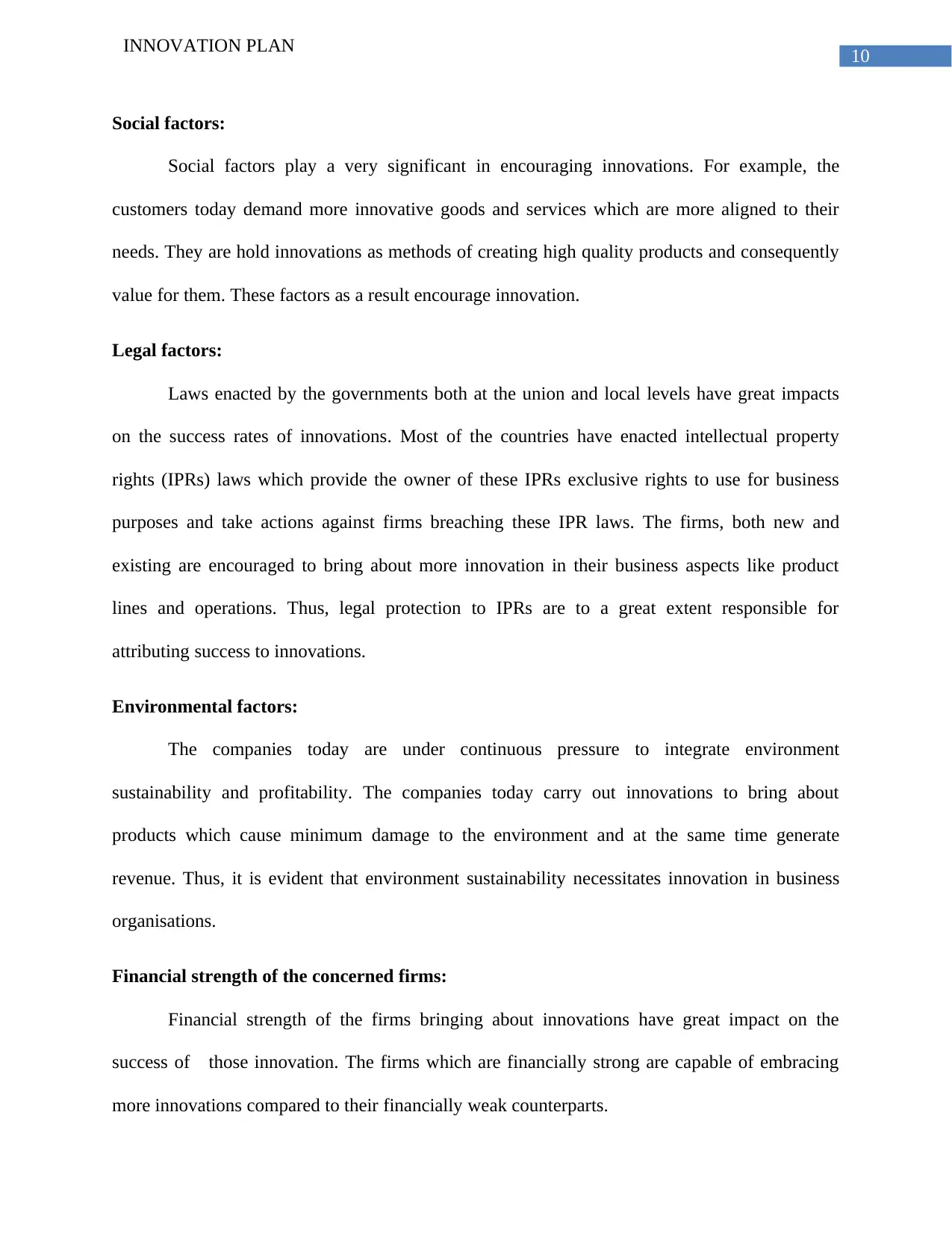
10
INNOVATION PLAN
Social factors:
Social factors play a very significant in encouraging innovations. For example, the
customers today demand more innovative goods and services which are more aligned to their
needs. They are hold innovations as methods of creating high quality products and consequently
value for them. These factors as a result encourage innovation.
Legal factors:
Laws enacted by the governments both at the union and local levels have great impacts
on the success rates of innovations. Most of the countries have enacted intellectual property
rights (IPRs) laws which provide the owner of these IPRs exclusive rights to use for business
purposes and take actions against firms breaching these IPR laws. The firms, both new and
existing are encouraged to bring about more innovation in their business aspects like product
lines and operations. Thus, legal protection to IPRs are to a great extent responsible for
attributing success to innovations.
Environmental factors:
The companies today are under continuous pressure to integrate environment
sustainability and profitability. The companies today carry out innovations to bring about
products which cause minimum damage to the environment and at the same time generate
revenue. Thus, it is evident that environment sustainability necessitates innovation in business
organisations.
Financial strength of the concerned firms:
Financial strength of the firms bringing about innovations have great impact on the
success of those innovation. The firms which are financially strong are capable of embracing
more innovations compared to their financially weak counterparts.
INNOVATION PLAN
Social factors:
Social factors play a very significant in encouraging innovations. For example, the
customers today demand more innovative goods and services which are more aligned to their
needs. They are hold innovations as methods of creating high quality products and consequently
value for them. These factors as a result encourage innovation.
Legal factors:
Laws enacted by the governments both at the union and local levels have great impacts
on the success rates of innovations. Most of the countries have enacted intellectual property
rights (IPRs) laws which provide the owner of these IPRs exclusive rights to use for business
purposes and take actions against firms breaching these IPR laws. The firms, both new and
existing are encouraged to bring about more innovation in their business aspects like product
lines and operations. Thus, legal protection to IPRs are to a great extent responsible for
attributing success to innovations.
Environmental factors:
The companies today are under continuous pressure to integrate environment
sustainability and profitability. The companies today carry out innovations to bring about
products which cause minimum damage to the environment and at the same time generate
revenue. Thus, it is evident that environment sustainability necessitates innovation in business
organisations.
Financial strength of the concerned firms:
Financial strength of the firms bringing about innovations have great impact on the
success of those innovation. The firms which are financially strong are capable of embracing
more innovations compared to their financially weak counterparts.
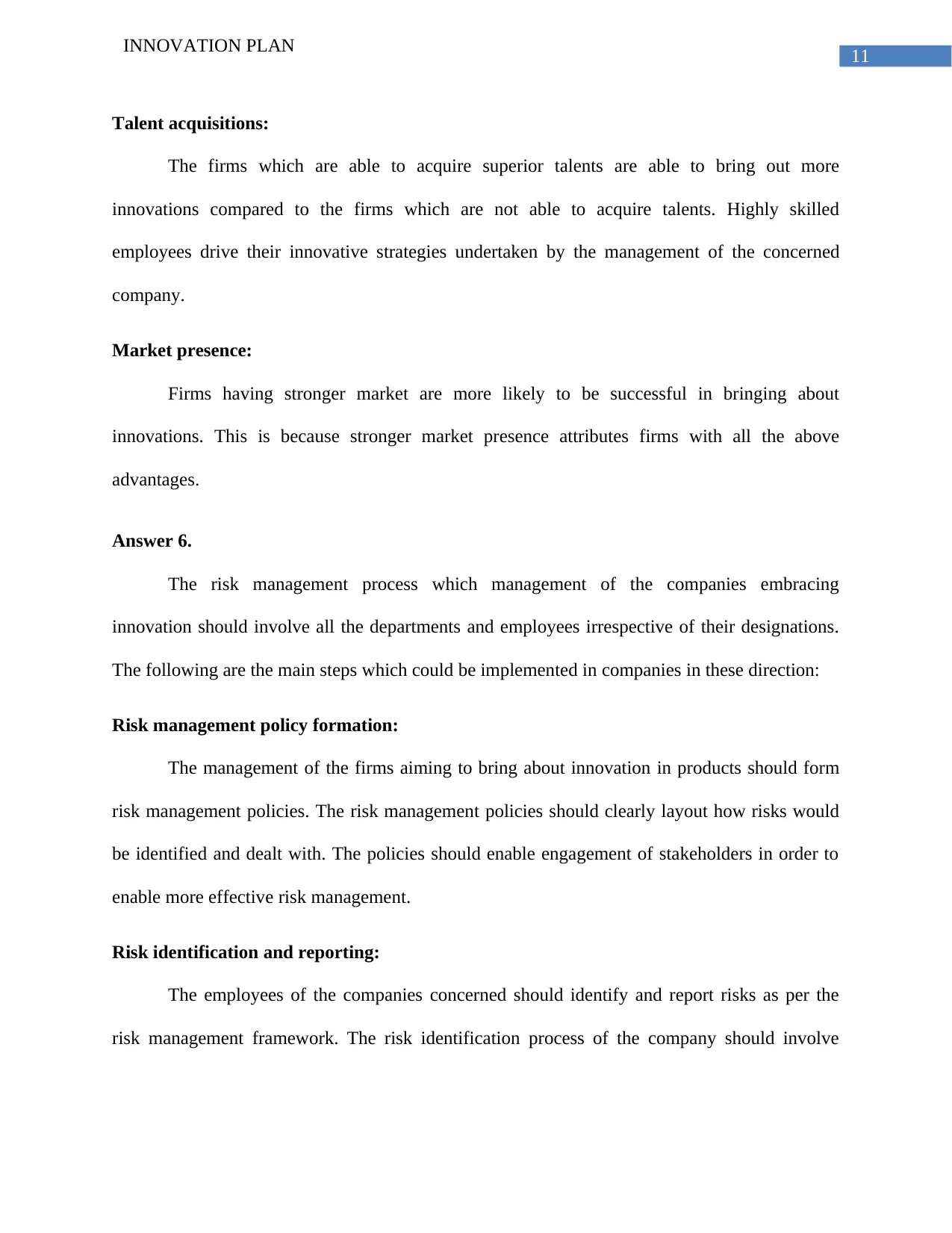
11
INNOVATION PLAN
Talent acquisitions:
The firms which are able to acquire superior talents are able to bring out more
innovations compared to the firms which are not able to acquire talents. Highly skilled
employees drive their innovative strategies undertaken by the management of the concerned
company.
Market presence:
Firms having stronger market are more likely to be successful in bringing about
innovations. This is because stronger market presence attributes firms with all the above
advantages.
Answer 6.
The risk management process which management of the companies embracing
innovation should involve all the departments and employees irrespective of their designations.
The following are the main steps which could be implemented in companies in these direction:
Risk management policy formation:
The management of the firms aiming to bring about innovation in products should form
risk management policies. The risk management policies should clearly layout how risks would
be identified and dealt with. The policies should enable engagement of stakeholders in order to
enable more effective risk management.
Risk identification and reporting:
The employees of the companies concerned should identify and report risks as per the
risk management framework. The risk identification process of the company should involve
INNOVATION PLAN
Talent acquisitions:
The firms which are able to acquire superior talents are able to bring out more
innovations compared to the firms which are not able to acquire talents. Highly skilled
employees drive their innovative strategies undertaken by the management of the concerned
company.
Market presence:
Firms having stronger market are more likely to be successful in bringing about
innovations. This is because stronger market presence attributes firms with all the above
advantages.
Answer 6.
The risk management process which management of the companies embracing
innovation should involve all the departments and employees irrespective of their designations.
The following are the main steps which could be implemented in companies in these direction:
Risk management policy formation:
The management of the firms aiming to bring about innovation in products should form
risk management policies. The risk management policies should clearly layout how risks would
be identified and dealt with. The policies should enable engagement of stakeholders in order to
enable more effective risk management.
Risk identification and reporting:
The employees of the companies concerned should identify and report risks as per the
risk management framework. The risk identification process of the company should involve
⊘ This is a preview!⊘
Do you want full access?
Subscribe today to unlock all pages.

Trusted by 1+ million students worldwide
1 out of 33
Related Documents
Your All-in-One AI-Powered Toolkit for Academic Success.
+13062052269
info@desklib.com
Available 24*7 on WhatsApp / Email
![[object Object]](/_next/static/media/star-bottom.7253800d.svg)
Unlock your academic potential
Copyright © 2020–2025 A2Z Services. All Rights Reserved. Developed and managed by ZUCOL.




